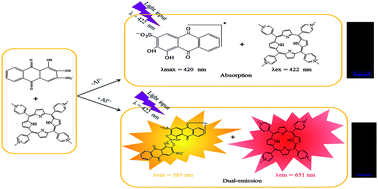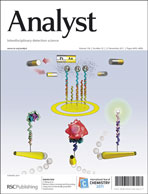A dual-signal sensing system based on the inner-filter effect (IFE) was demonstrated, in which the combination of two signaling mechanisms allows metal binding to turn on two fluorescence emission bands, independently. A proof-of-concept fluorescent ratiometric assay for Al3+ in pure aqueous solution is presented. The proposed assay is based on the Al3+-induced color and fluorescence changes of Alizarin red S (ARS) and IFE between ARS and meso-tetra(N-methyl-4-pyridyl)porphine tetratosylate salt (TMPyP). In the absence of Al3+, the absorption spectrum of the ARS in 0.2 M HAc–NaAc buffer (pH 5.5) has a strong peak at 420 nm, significantly overlapping with the excitation of TMPyP. ARS is expected to be capable of functioning as a powerful absorber to tune the emission of TMPyP on account of the spectral overlap. Binding of Al3+ with ARS forms a fluorometric ARS/Al3+ complex and shifts the maximum absorbance from 420 nm to 480 nm, which overlaps negligibly with the excitation of TMPyP and turns on the proper emission spectrum for TMPyP. Under the optimum conditions, The fluorescence intensity ratio, F585/F651, responds to Al3+ over a dynamic range of 0.1–1.5 μM, with a limit of detection of 40 nM, where F585 and F651 are the fluorescence intensity at 585 nm and 651 nm in the absence or presence of Al3+, respectively. Further application in Al3+-spiked water samples suggested a recovery between 95 and 108%. The fluorescence response is highly selective for Al3+ over other metal ions with the addition of thiourea as the masking agent.

You have access to this article
 Please wait while we load your content...
Something went wrong. Try again?
Please wait while we load your content...
Something went wrong. Try again?


 Please wait while we load your content...
Please wait while we load your content...